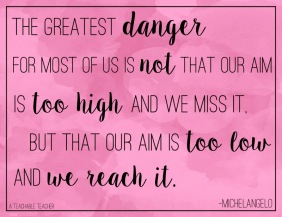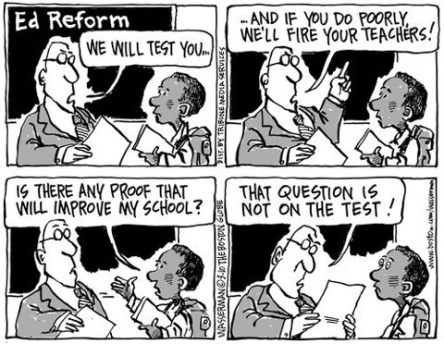
I’m sitting in a leadership team meeting listening as team members engage in conversation regarding student data. District wide, we are monitoring student progress in two significant areas, reading and writing. The data shows growth within the district, however, our students continue to perform low comparative to the norm. The question is posed, “Why would some teachers implement a strategy and others not?” I took a moment to reflect. My summation, stereotype threats are real and it is with these threats that our students unknowingly fall victim to their current circumstances.
Stereotype threat refers to an individual being at risk of confirming a negative stereotype about their group (Steele & Aronson,1995). We’ve encountered many stereotype threats in our day. Threats like, boys are stronger in math than girls, Asians are stronger in math than whites, blacks are better athletes than whites; all are examples of stereotypes that threaten the success of the individuals that identify with these particular groups. I couldn’t help but stop and think about this in the context of our current conversation.
According to our district’s state report card, approximately 66% of the district is identified as minority, 49% are Hispanic students, 17% Black. Of equal importance, 98% of the district is economically disadvantaged (2015-2016 Ohio Department of Education Report Card, retrieved November 24, 2016). Stereotype threats are looming throughout the local community. We hear some of them from parents during conferences and sadly even within the halls of the schools. In a district where language is a constant barrier and education lacking, at best, our students unconsciously inherit the limitations that have stunted the success of their parents. This is important to know because it speaks not only to the level of confidence our students come to us with, but also the level of efficacy we as teachers have to address these threats.
It’s a fact that our students are faced with challenges. Our perception of what it must be like to live in poverty is our students’ sad reality. But, are their circumstances truly indicative of their ability to be successful students? What is our role in ensuring that our students do not fall victim to their unwelcome circumstances?
As educators, it is my opinion that we first look at poverty differently. It is not a disability, it’s an obstacle. It’s a mindset that exists because the people in and around our students lives have yet to figure out how to change their circumstances or are unaware of the resources available to assist in changing them. Once we ourselves believe that our students circumstances are systemic rather than defining in nature, we need to be purposeful and intentional about working to change their mindset. Their mindset has been fixed on stereotype threats for much of their schooling already. I imagine it is difficult for them to think of anything different. Many of our students that are struggling readers come to us already years behind their peers. Place on top of that, being a non-English speaker. Some of our parents didn’t finish high school or get past the 8th grade for that matter. Think about the conversation happening in these homes. The fears and failures of the parents are now threats that hinder our students growth and progress. But it doesn’t have to.

It is imperative that we raise our expectations. I understand that as educators, we don’t want to see our students fail. Their failures do become our own. However, we have to refrain from lowering expectations to meet our own needs. This is not about us. Our job is to provide all students with a quality education. That means we need to empower them. We need to continue raising our expectations and providing instruction that will challenge students thinking. We have to realize that when we show our students how much we believe in them, they will begin to not only believe in themselves, but, they will perform. So, raise the bar! As we begin to break down the threat barriers that are hindering our students, they will begin to reach for the bar where it has been set for them.

Continuing to limit the growth of our students by succumbing to the belief that they cannot perform at the same rate or level as their peers is so damaging. And think about it, if we cannot ourselves break away from the stereotype threats, then who are the real victims of circumstance? We should know and do better.
References
American Psychological Association (2006). Stereotype threat widens achievement gap. Washington, D.C.: author
Ohio Department of Education (2016). Annual District Report Card, 2015-2016.
Reducing Stereotype Threats. Stereotype Threats. Retrieved from ReducingStereotypeThreats.org on November 24, 2016.
Steele, C. M., & Aronson, J. (1995). Stereotype threat and the intellectual test performance of African-Americans. Journal of Personality and Social Psychology, 69, 797-811.
Tyler, K. & Tyler, C. (2009). Stereotype Threat. Classroom Learning. Retrieved from Education.com, November 24, 2016.




 For the last few weeks, I’ve been thinking a great deal about the upcoming PARCC. I’m speaking of the Next Generation Assessment known as the Partnership for Assessment of Readiness for College and Careers. If you thought the Ohio Achievement Assessment was bad, then wait until you see THIS! I suggest, if you haven’t yet taken a look at this new online assessment, you should…and soon!
For the last few weeks, I’ve been thinking a great deal about the upcoming PARCC. I’m speaking of the Next Generation Assessment known as the Partnership for Assessment of Readiness for College and Careers. If you thought the Ohio Achievement Assessment was bad, then wait until you see THIS! I suggest, if you haven’t yet taken a look at this new online assessment, you should…and soon!


